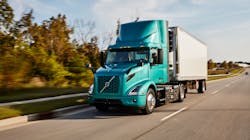I want to talk about our old friend the S-curve. At NACFE, we often use the S-Curve to talk about the rate at which technology gets adopted, but it can also be used to describe product maturity. For example, diesel-powered trucks are on the flat part at the end of the curve, but electric vehicles are at the bottom of the beginning of the curve where it is possible for big improvements to take place. Conversely, the more mature a technology, the harder it is for there to be big breakthrough improvements.
A note of caution here, just because a product is mature does not mean improvements are no longer possible. While we at NACFE firmly believe that the future is electric, we also know that shifting the trucking industry to one where all vehicles are powered by batteries is a process that will take place over the course of decades. To put it bluntly, while we are moving into the electric future, internal combustion engines (ICE) will still be powering at least some trucks for a while longer. And there is still room for those trucks to produce fewer greenhouse gas emissions and improve fuel economy.
In a recent report, Truck OEM Strategies for GHG/CO2 Regulation Compliance, 2020-2030, Frost & Sullivan found there are a variety of ways to make trucks more efficient. Saideep Sudhakar, research manager of mobility practice at Frost & Sullivan, said, “In the wake of stringent fuel efficiency norms and greenhouse gas emissions regulations. OEMs are evaluating a combination of advanced engine combustion technologies and energy recovery strategies, spanning advanced aerodynamics, auxiliary electrification high-efficiency transmission, innovative driver assistance systems, and low rolling resistance tires.”
So, what’s my point? Well, it is one I have made many times in the past. We need to marshal resources and get the best and brightest minds from within our industry as well as from adjacent industries and even from the high-tech world to work on advancing electric vehicle technology so that the total cost of ownership makes sense for fleets. In addition, we need more fleets to start piloting EVs in their fleets so we can get more data about how they perform in the real world.
At the same time, we need to continue to make changes to ICE engines. Sure, we won’t see leaps and bounds improvements in the MPG of diesel-powered trucks, nor will we see major reductions in GHG and CO2 emissions. However, we can continue to make some incremental improvements that will help make diesel cleaner as we negotiate our way through the “messy middle” to our cleaner, electric future.
If you asked me to pick one of these options over the other, I would have to tell you that my answer is both and I am confident that this industry can deliver on both speeding up electric truck developments and making diesels cleaner.
We got this.
Michael Roeth has worked in the commercial vehicle industry for nearly 30 years, most recently as executive director of the North American Council for Freight Efficiency. He currently serves on the second National Academy of Sciences Committee on Technologies and Approaches for Reducing the Fuel Consumption of Medium and Heavy-Duty Vehicles and has held various positions in engineering, quality, sales and plant management with Navistar and Behr/Cummins.
About the Author

Michael Roeth
Executive Director
Michael Roeth is the executive director of the North American Council for Freight Efficiency. He serves on the second National Academy of Sciences Committee on Technologies and Approaches for Reducing the Fuel Consumption of Medium and Heavy-Duty Vehicles and has held various positions with Navistar and Behr/Cummins.
